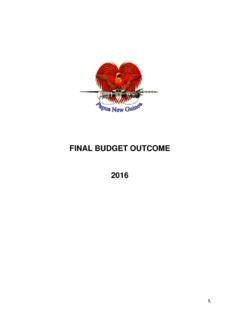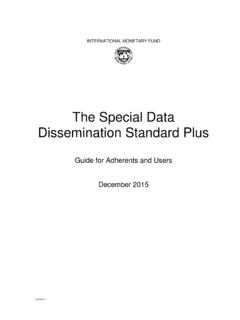Transcription of MID-YEAR ECONOMIC AND FISCAL OUTLOOK …
1 MID-YEAR ECONOMIC AND FISCAL OUTLOOK . REPORT. 2017. Table of Contents INTRODUCTION .. 1. PART 1 .. 2. THE MID-YEAR ECONOMIC AND FISCAL OUTLOOK .. 2. ECONOMIC OUTLOOK .. 2. International ECONOMIC OUTLOOK A Firming Recovery .. 2. Commodity Prices .. 4. Exchange Rate 7. Domestic ECONOMIC 8. 2017 ECONOMIC OUTLOOK .. 8. Employment .. 10. Inflation OUTLOOK .. 11. Monetary 13. Balance of Payments .. 14. International 16. THE FISCAL OUTLOOK .. 16. TOTAL REVENUE AND GRANTS .. 17. TAX 18. Taxes on Payroll and Workforce .. 18. Taxes on Goods and 19. Taxes on International Trade and Transactions .. 19. GRANTS .. 20. OTHER REVENUE .. 20. REVENUE MEASURES UPDATE .. 21. EXPENDITURE AND NET 21. Operational Budget Expenditure.
2 22. Capital Budget 24. STATUS OF TRUST ACCOUNTS .. 25. District Services Improvement Program (DSIP) Trust Accounts .. 26. 27. External Funding .. 27. Domestic Funding .. 27. 2017 Net Financing .. 29. PUBLIC 29. 1. RISKS TO THE MID-YEAR ECONOMIC AND FISCAL OUTLOOK .. 30. 2017 AND BEYOND .. 31. FISCAL OUTTURN TABLES .. 32. PART 2 .. 38. 2017 MID - year EXPENDITURE .. 38. FUNDED EXPENDITURE SINCE THE 2017 BUDGET .. 38. APPROPRIATION TRANSFERS .. 39. Section 3 Transfers (Secretary's Advance).. 39. Section 4 Transfers .. 40. 2017 BUDGET EXECUTION .. 40. Spending on the Medium Term Development Plan (MTDP) Enablers .. 41. FUNDING FOR CAPITAL INVESTMENT EXPENDITURE .. 42. GRANT FINANCING .. 43. PART 3 1.
3 2. INTRODUCTION. The MID-YEAR ECONOMIC and FISCAL OUTLOOK (MYEFO) Report is released in accordance with the requirements of sections 9 to 12 of the Papua New Guinea FISCAL Responsibility Act (FRA). 2006. The purpose of the MYEFO Report is to provide updated FISCAL information, especially for the current financial year , to allow the Parliament and the public to assess developments against those set out in the 2017 Budget. The MYEFO contains the following: Part 1: The MID-YEAR ECONOMIC and FISCAL OUTLOOK The ECONOMIC OUTLOOK The FISCAL OUTLOOK Total Revenue and Grants Expenditure and Net Lending Status of Trust Accounts Financing Public Debt Risks to the MID-YEAR ECONOMIC and FISCAL OUTLOOK 2017 and Beyond FISCAL Outturn Tables Part 2: MID-YEAR Expenditure Estimates by Agency Funded Expenditure since the 2017 Budget 2017 Budget Execution Part 3: Attachments The MYEFO essentially covers General Government FISCAL and financial operations in the government sector and is based on the same reporting standards as the 2017 Budget.
4 Generally, this follows the cash reporting standards laid down in the Government Finance Statistics (GFS) Manual 2014 published by the International Monetary Fund (IMF). This is a gradual shift from the 1986 GFS to the 2014 GFS and is part of the ongoing reform of the Budget process and Budget reporting. The information on National Account presented in this report is based on the official release by National Statistical Office in December 20161. 1. The Gross Domestic Product (GDP) has been rebased to 2013. 1. PART 1. THE MID-YEAR ECONOMIC AND FISCAL OUTLOOK . ECONOMIC OUTLOOK . International ECONOMIC OUTLOOK A Firming Recovery According to the 2017 July World ECONOMIC OUTLOOK (WEO) report published by the International Monetary Fund (IMF), the global ECONOMIC activity remains on track maintaining a pick-up in growth as reported in the April WEO.
5 Global growth for 2016 is estimated at per cent, slightly higher than the 2017 April forecast, primarily reflecting much higher growth in Iran and stronger activity in India following national accounts revisions. In 2017, global growth is projected at per cent and per cent in 2018. The unchanged global growth projections mask somewhat different contributions at the country level. The US growth projections are lower than those in April, primarily reflecting the assumptions that FISCAL policy will be less expansionary going forward than previously anticipated. Growth has been revised up for Japan and the euro area, where positive surprises to activity in late 2016 and early 2017 point to solid momentum.
6 China's growth has also been revised up, reflecting a strong first quarter of 2017 and expectations of continued FISCAL support. Although projected global growth rates for 2017-18 are higher than the per cent estimated for 2016, are below pre-crisis averages, especially for most advanced economies and for commodity-exporting emerging and developing economies. Among the former, many face excess capacity as well as headwinds to potential growth from aging populations, weak investment, and slowly advancing productivity. 2. Chart 1: World ECONOMIC Growth (1983-2018). Per cent Per cent 6 6. Forecast 5 5. 4 4. 3 3. 2 2. 1 1. 0 0. -1 -1. 1983 1988 1993 1998 2003 2008 2013 2018. Source: International Monetary Fund, World ECONOMIC OUTLOOK (July) 2017.
7 Growth in the advanced economies is projected at per cent and per cent for 2017 and 2018 in the July 2017 WEO respectively compared to per cent and per cent projected as at the April 2017 WEO. Growth in the US has been revised down from per cent to per cent for 2017and from per cent to per cent in 2018. While downward revision in the 2017 forecast reflects in part the weak growth outturn in the first quarter of the year . FISCAL policy will continue to be less expansionary than previously assumed, given the uncertainty about the timing and the nature of the USA FISCAL policy changes and market expectations of FISCAL stimulus have also receded. The growth forecast in the United Kingdom (UK) has also been revised down for 2017 on weaker-than-expected activity in the first quarter which contrasted with other Euro area countries, including France, Germany, Italy and Spain, growth for the first quarter was generally above expectations mainly driven by stronger momentum in domestic demand.
8 Canada's growth forecast was also revised upwards driven by a buoyant domestic demand boosting growth to per cent and key ECONOMIC indicators pointing to a resilient second- quarter. Japan, where private consumption, investment, and exports support first-quarter growth. In the Emerging Markets and Developing Economies (EMDEs), growth is projected to see a sustained pickup in activity with growth rising from per cent in 2016 to per cent in 2017. and per cent in 2018. These forecasts reflect upward revisions, relative to April, of percentage point for 2016, and percentage for 2017 primarily driven by commodity importers, but its pickup reflects a gradual improved conditions in large commodity exporters that have experienced recession in 2015-16.
9 3. China's growth is expected to remain at per cent in 2017, the same level as in 2016, and to decline only modestly in 2018 to per cent. The forecast for 2017 was revised up by percentage point reflecting the stronger than expected outturn in the first quarter of the year underpinned by previous policy easing and supply-side reforms. For 2018, the upward revision of percentage point mainly reflects expectation that authorities will delay the needed FISCAL adjustment thus maintaining high public investment to meet their target of doubling 2010 real GDP by 2020. Growth in India is forecast to pick up further in 2017 and 2018, in line with the April 2017. forecast. While activity slowed following the currency exchange initiative, growth for 2016 is estimated at per cent, higher than anticipated due to strong government spending and data revisions that showed stronger momentum in the first part of the year .
10 Over the medium- term, the global growth is projected to gradually increase to per cent by 2022, driven by the EMDEs, reflecting strengthening of growth in commodity exporters, an acceleration of activity in India resulting from the implementation of structural reforms and a successful rebalancing of China's economy to trend growth rates Commodity Prices Mineral Commodities Movements in commodity prices continued to track developments in the global economy over the first half of 2017. The IMF Commodity Price Index rose by per cent, compared to the corresponding period of 2016. Prices of PNG's key export commodities, especially oil continues to be influenced by the OPEC and non-OPEC supply cut agreement and the US.








